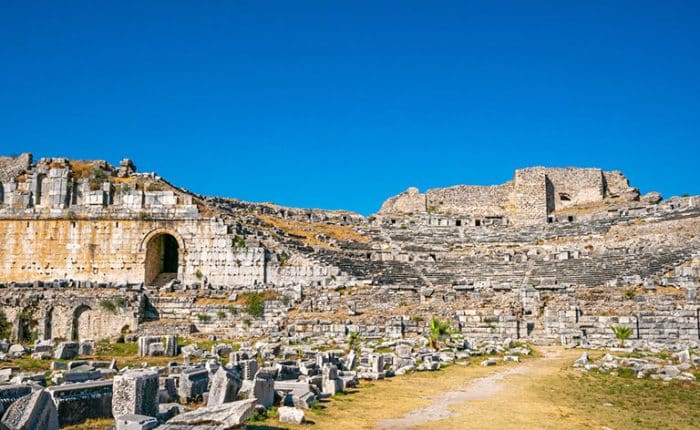Archeological excavation shows that people lived in the area as early as the Neolithic period (3500-3000 BCE), when this area consisted of a group of islands at the mouth of the Meander.
However, the seeds of a city sprouted during the 2nd millennium BCE. The native inhabitants started trading with the Minoan civilization, and settlers from Crete made their way into the region. By the 13th century BCE, mentions of an extensive settlement began appearing in the notes of the Hittite Empire.
The 11th and 10th centuries BCE saw the arrival of Greek colonialists who took over the towns and established a city that would start prospering from the 7th century onwards. The Greeks, now called the Milesians, also established around 90 colonies in Asia Minor, Egypt, and Eastern Europe (Ukraine), using the city as their base.
Miletus’ location on a natural bay made it a prime destination for traders from all over the known world.
Between the 6th and the 1st centuries BCE, the city underwent an eventful 500 year period that saw it captured, take part in a rebellion, get destroyed in retaliation, rebuilt, liberated, attacked by its liberators, and finally, enjoy a period of peace and success under the Ionian league of cities.
Under the Romans, Miletus maintained its importance in the region and enjoyed relative prosperity. The Byzantines then took over and made the city the seat of archbishops. Over the next six centuries, Miletus slowly declined partly due to sedimentation of its harbor by the River meander.
It was then abandoned in the invasion period of the 7th to the 9th centuries CE. When the Ottomans conquered the region in the 15th century, Miletus was nothing but a small village of few inhabitants. Two centuries later, the ruins had been completely abandoned.
Miletus came under Persian control in 546 BCE. But refusing to stay conquered, the city banded up with other Ionian cities and launched a briefly successful rebellion. The Persians responded swiftly and harshly by conquering Miletus and destroying the original town.
Fortunately, the Milesians, being resourceful people, put a lot of effort into reconstructing their home. This endeavor was led by the famed architect Hippodamus in 479 BCE, who formulated ideas of urban development that would become the basic plan of several other cities in the region.
The new layout followed a grid system where houses and streets were aligned to take advantage of the sun, wind, and local scenery. In addition, he (Hippodamus) planned the streets and buildings such that the winds from the sea and mountains would flow optimally through the city to provide a cooling effect during summer.
This implementation was the first of its kind. Houses were divided into blocks by streets and side streets that crossed each other at right angles while public buildings occupied the city center. This plan is still visible in the ruins of Miletus, but the city of Priene offers a more detailed and better-preserved example.
Miletus architecture resembled that of most Greek cities of the time. And following the idea of rational urban planning, some houses in the town used solar architecture. This meant that they were oriented to take maximum advantage of the sun during winter and obscure its rays during summer to keep temperatures comfortable enough for its inhabitants.



The ruins of Miletus offer a lot to see when the water levels are low. As you approach the city, you are welcomed by the remains of a magnificent theater that was once the entertainment hub for 15,000 Milesians.
Here, they cheered bloody battles between gladiators and/or fierce animals. And on days when their thirst for blood and adrenaline levels were low, the audience silently enjoyed legendary performances of plays written by the talented poets and narrators of the time.
Thirty meters high and 140 meters wide, it is a fascinating place to be. Even more intriguing is the fact that in antiquity, the theater stood on the seafront. Spectators only had to look the other way, and they would enjoy spectacular views of the turquoise water and merchant ships sailing in and out of the city’s harbor.
Above the theatre’s third tier of seats is a tower constructed when a new wall was added to the city in the 7th century. It’s not much of a sight in itself, but climbing there allows you to enjoy panoramic views of this part of the Turkish interior.
Further lower from the theater is a 15th-century mosque with four columns. It is known as the Ilyas Bey Mosque and is one of the few Ottoman structures in the city.
But before you get there, follow the main road to explore impressive late-Roman and Byzantine-era buildings. These include the Faustina bath, built in dedication to Marus Aurelius’ wife, a gymnasium, baths, agoras, and the Bouleuterion.
There are other attractions within an hour’s drive from Miletus, including Priene, Didyma, and the Temple of Apollo.